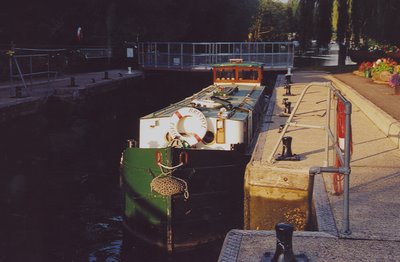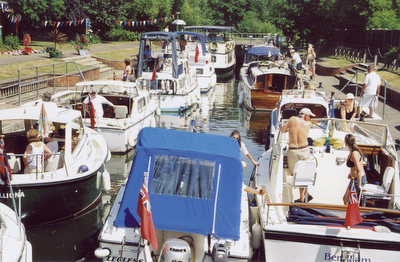The locks on the Thames are somewhat different to those I’ve used on the canals.
In my regular haunts, between Camden, Cowley and Hanwell, there are over 20 miles of canal with no locks and it’s easy to cover a long distance quickly. In other places such as around Marsworth there are several locks per mile and the going is much slower. On the canals you usually operate the locks yourself. You use a metal tool called a windlass to open and close sluice gates to let water in or out of the lock; then pull on wooden beams to open the gates to let the boat in or out. The boat has to be tied up carefully so it doesn’t crash into the lock gates or, worse, damage the propellor on the stone cill, its position marked by white paint. It can be fun, especially at places like Camden and Stoke Bruerne where crowds of tourists stand and watch you working; it can be good exercise; but in foul weather it’s far less enjoyable and the stone sides of the lock can get slippery. Here’s an animation that shows how a lock works.
Working locks is easier if you have a crew but I usually travel alone so it’s always handy to be able to share a lock with another boat.
The locks on the Thames are much easier to cope with if you’re boating alone. They are all manned by (so far) friendly and helpful lock keepers who can help you attach your ropes to the bollards and offer advice – and make sure you’ve paid your license! Longer ropes are needed on the Thames and, whereas on the canals I would just tie up a single rope from the centre of the boat’s roof, here both bow and stern ropes must be tied. I prefer to stand on the middle of the top of the boat holding both ropes tight to keep the boat from straying.
What’s amazed me is the number of boats that can share one of the locks on the Thames. On the canals there’s only room for two boats but yesterday on a busy, hot Sunday, there were over a dozen boats in the lock below Windsor with more boats queueing behind them. The lock keeper had to make sure they were all roped up safe and secure before using the control panel to automatically open the sluice gates.
One keeper put a portable tv on top of my boat and asked me to deliver it to the keeper at the next lock. He’d borrowed it to watch England lose a match. My first cargo.
According to the website of one of the lock keepers at Teddington, if you were going to empty the Launch Lock by drinking the water in it, at the recommended daily rate of 2 litres of water a day, it would take just over 3,000 years to drink it dry. This site at www.teddington-lock.co.uk is well worth a visit, just for the photo of the yellow submarine!


Just found your website and am thoroughly enjoying the read! Keep it up!